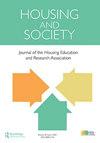南卡罗来纳县的军人和退伍军人精神痛苦率和军民居住隔离
Q2 Social Sciences
引用次数: 5
摘要
摘要:我们调查了南卡罗来纳州各县的服役人员/退伍军人(SMV)精神痛苦率和军民居住隔离(MCRS)。在我们分析的第一阶段,我们使用2017年行为风险因素监测系统(BRFSS)的个人水平数据,通过广义线性混合模型(GLMM)使用小面积估计(SAE)来计算SMV中精神痛苦率的概率。我们将这些概率应用于美国人口普查局在县一级编制的人口统计(即年龄、种族、性别、军事地位),以确定每个县的SMV精神困扰率。在第二阶段,我们使用这些计算的精神困扰率和2013-2017年美国社区调查(ACS)数据来计算各县的MCRS,并评估SMV精神困扰率与MCRS之间的关系。第一阶段的结果显示,尽管我们发现各县的地理差异,但SMV的平均预测精神痛苦率为9.33%。第二阶段的结果显示,与低MCRS相比,高MCRS县的平均精神痛苦率更高(9.58对9.22)(Cohen’s d=0.62)。在MCRS高的地方,SMV和平民需要社会联系机会。本文章由计算机程序翻译,如有差异,请以英文原文为准。
Service member and veteran mental distress rates and military-civilian residential segregation in South Carolina counties
ABSTRACT We examine service member/veteran (SMV) mental distress rates in South Carolina counties and military-civilian residential segregation (MCRS). In phase one of our analysis, we utilized small area estimation (SAE) via a generalized-linear mixed model (GLMM) to calculate the probability of mental distress rates among SMVs, using individual-level data from the 2017 Behavioral Risk Factor Surveillance System (BRFSS). We applied these probabilities to demographic population counts (i.e. age by race by sex by military status) prepared at the county level by the U.S. Bureau of the Census in order to develop rates of SMV mental distress for each county. In phase two, we used these calculated mental distress rates and block-group-level 2013–2017 five-year American Community Survey (ACS) data to calculate MCRS for counties and to assess the relationship between SMV mental distress rates and MCRS. Phase one results showed that the average predicted mental distress rate among SMVs was 9.33 percent, although we found geographic variation across counties. Phase two results showed that the average mental distress rate was higher in counties with high compared to low MCRS (9.58 vs. 9.22) (Cohen’s d = 0.62). Social connection opportunities for SMVs and civilians are needed where high MCRS occurs.
求助全文
通过发布文献求助,成功后即可免费获取论文全文。
去求助
来源期刊

Housing and Society
Social Sciences-Urban Studies
CiteScore
2.30
自引率
0.00%
发文量
10
期刊介绍:
Housing and Society is the journal of the Housing Education and Research Association (HERA). The journal supports the mission of HERA by providing for the dissemination of research and other scholarly work. Submissions from a broad range of perspectives are encouraged. Topics in housing include: policy, design, social aspects, gerontology, behavioral aspects, energy/environment, equipment, interiors, economics, theory/model development, education, and program development or evaluation. The journal welcomes the submission of original research articles, notes and commentaries. Notes are shorter manuscripts presenting succinct information on housing related to one of the following categories: - Research: exploratory or not heavily theory-based or statistically analyzed - Academic: innovative teaching ideas - Program: development, implementation, and/or evaluation of Cooperative Extension or other housing programming efforts - Policy: examination of policy impact, comparative analysis, and/or need to achieve housing goals - Reviews: books, documentaries, etc.
 求助内容:
求助内容: 应助结果提醒方式:
应助结果提醒方式:


